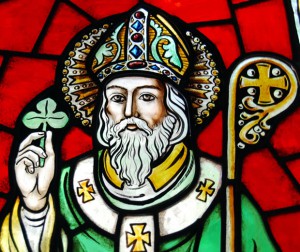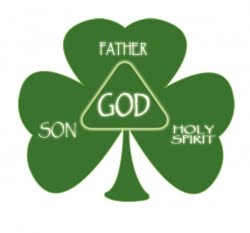
Much of the information in this article is a taken from this source: http://christiananswers.net/q-eden/patrick.html also see this article: http://truthontheweb.org/patrick.htm
Patrick was born in the year 373 A.D. in a town on the River Clyde in Roman Britain. When he was sixteen years old, Patrick was captured by a band of Irish pirates who sold him to a chieftain in Northern Ireland. For six years he tended flocks of animals as a slave until he escaped and returned to his family. It was during the time of his captivity that he turned from his careless ways and came to a saving knowledge of Christ Jesus. He was convicted that he was a sinner. In his own words, like the Apostle Paul, he received a clear and personal call from the Lord to preach the gospel in the land of his former captivity.
“Thus I am a servant in Christ to a foreign nation for the unspeakable glory of life everlasting which is in Christ Jesus our Lord.”
“I, Patrick, a sinner, a most simple countryman, the least of all the faithful and most contemptible to any.”
Quite clearly, Patrick saw himself as a sinner. He did not look to some spark of life from within himself or to some ritual; rather, he looked unto Christ Jesus. Patrick’s words, “unspeakable glory of life every lasting which is in Christ Jesus our Lord” shows his distinct and personal comfort and courage in Christ. Totally unlike religion that looks to rituals, Patrick had his eyes set on the Lord. Catholicism now and during Patrick’s time, looks to sacraments as the means to salvation. Patrick saw himself only as a sinner “saved by grace” in Christ Jesus. Patrick’s message is that salvation is totally “in Christ alone” a message utterly diverse from that of Roman Catholicism, then and now.
Patrick, the Christian Evangelist, being about 30 years old and together with some brothers in the Lord, set out for Ireland. He arrived in or about the year 405. This fact of history is authentic and verified. For example, Marcus, an Irish Bishop, who lived at the beginning of the ninth century, states that Patrick (32 years old) came to Ireland in the year 405 AD and Nennius, who lived about the same time, repeats the statement. This date is of great importance because many centuries later there was an attempt made to confuse Patrick with Palladius.
When news of Patrick’s Christian success had reached Rome, Pope Celestine sent Palladius as a bishop to “bring the churches under the control of the Papacy”. It was in 432, at least 27 years after Patrick’s commission from God, that Palladius from Rome came on the scene. When Palladius did come to Ireland, he discover many Christian churches which did not accept subservience to the Bishop of Rome. In actual fact, Palladius was greatly discouraged by his lack of success in bringing them under the control of the Papacy.
Patrick wrote of baptizing many thousands of believers after they had professed faith. He also wrote about anxious journeys, difficulties, and disappointments. He combated the powers of darkness in the priesthood of the Druids. He relied on Christ Jesus and the glorious Holy Spirit given to convict people of sin, of righteousness and judgment. He understood grace to be entirely from God when he declared:
“I, alone, can do nothing unless He Himself vouchsafes it to me. But let Him search my heart and [my] nature, for I crave enough for it, even too much, and I am ready for Him to grant me that I drink of His chalice, as He has granted to others who love him. Therefore, may it never befall me to be separated by my God from His people whom He has won in this most remote land. I pray God that He gives me perseverance, and that He will deign that I should be a faithful witness for His sake right up to the time of my passing.”
Over the course of 60 years, Patrick went the length and breadth of Ireland preaching the Gospel and like Timothy and Titus before him, he ordained elders and established churches. It is reckoned that at the end of his days there were 365 churches across the island. These were established, like the first churches of Biblical times with the people served by a pastor and elders. The authority of the pastor was one of service, rather than lording it over the people, as Jesus Himself said.
“the Son of Man did not come to be served, but to serve, and to give His life a ransom for many. – Matthew 20:28”
The monasteries set up by Patrick, were totally unlike the monasteries that were established under the Church of Rome. These monasteries were quite like those of the Vaudois and other early Christian churches of northern Italy and southern France, whereby men came aside for some years to be trained in the Scriptures and learned how to serve and evangelize.
During Patrick’s time, Rome actually deplored Patrick because he taught  people real Christianity “in Christ alone based on Scripture alone”, not based on allegiance to the heresy of Catholic traditions. At the time of Patrick death, he was considered a heretic by the Catholic church, not a saint. However much later, after the Catholic church ruined Patrick’s good work by bringing the Irish churches under the control of the Catholic Papacy, they decided to make him a saint. Here is how the Catholic church depicts St. Patrick, with an attire of pomp and an expression of Catholic authority that he never identified with.
people real Christianity “in Christ alone based on Scripture alone”, not based on allegiance to the heresy of Catholic traditions. At the time of Patrick death, he was considered a heretic by the Catholic church, not a saint. However much later, after the Catholic church ruined Patrick’s good work by bringing the Irish churches under the control of the Catholic Papacy, they decided to make him a saint. Here is how the Catholic church depicts St. Patrick, with an attire of pomp and an expression of Catholic authority that he never identified with.
 Shamrock: Legend (dating to 1726, according to the OED) also credits St. Patrick with teaching the Irish about the doctrine of the Holy Trinity by showing people the shamrock, a three-leafed plant, using it to illustrate the Christian teaching of how three figures are aspects of one god.[66] For this reason, shamrocks are a central symbol for St Patrick’s Day.
Shamrock: Legend (dating to 1726, according to the OED) also credits St. Patrick with teaching the Irish about the doctrine of the Holy Trinity by showing people the shamrock, a three-leafed plant, using it to illustrate the Christian teaching of how three figures are aspects of one god.[66] For this reason, shamrocks are a central symbol for St Patrick’s Day.
 Driving out Snakes: “At no time has there ever been any suggestion of snakes in Ireland, so [there was] nothing for St. Patrick to banish”. It’s admittedly an unlikely tale. Ireland is one of only a handful of places worldwide—including New Zealand, Iceland, Greenland, and Antarctica—that Indiana Jones and other snake-averse humans can visit without fear. The association may be more of a spiritual one, where the “snake” refers to Satan
Driving out Snakes: “At no time has there ever been any suggestion of snakes in Ireland, so [there was] nothing for St. Patrick to banish”. It’s admittedly an unlikely tale. Ireland is one of only a handful of places worldwide—including New Zealand, Iceland, Greenland, and Antarctica—that Indiana Jones and other snake-averse humans can visit without fear. The association may be more of a spiritual one, where the “snake” refers to Satan
“The LORD God said to the serpent,
“Because you have done this,
Cursed are you more than all cattle,
And more than every beast of the field;
On your belly you will go,
And dust you will eat
All the days of your life; – Genesis 3:14
Emerald Isle St. Patrick’s Day Festival: The town of Emerald Isle, N.C., where I live, has an annual St. Patrick’s Day Festival in March on a Saturday close to Patrick’s birthday. The festival is like most town festivals where vendors come to sell their wares and food wagons feed the hungry crowd. There is some attempt to have Irish music and people wear green and funny hats. Of course the big attraction is the green beer and the over indulgence in a good time. My church “Chapel by the Sea” sometimes sets up a table and sells cookbooks and hands out gospel tracks but if St. Patrick were alive I don’t think he would of approve of this festival held in his honor since the Bible and God’s saving grace are not the main attraction!
Be Thou My Vision:
I arise today through God’s strength to pilot me;
God’s might to uphold me,
God’s wisdom to guide me,
God’s ear to hear me,
God’s word to speak for me,
God’s hand to guard me,
God’s way to lie before me,
God’s shield to protect me afar and anear, alone or in a multitude.
St Patrick
According to mythology, when St. Patrick was a missionary in Ireland in the 5th century, King Logaire of Tara decreed that no one was allowed to light any fires until a pagan festival was begun by the lighting of a fire on Slane Hill. In a move of defiance against this pagan ritual, St. Patrick did light a fire, and, rather than execute him, the king was so impressed by his devotion that he let Patrick continue his missionary work. Three centuries later, a monk named Dallan Forgaill wrote the Irish poem, “Rop tú mo Baile” (“Be Thou my Vision), to remember and honor the faith of St. Patrick. Forgaill was martyred by pirates, but his poetry lived on as a part of the Irish monastic tradition for centuries until, in the early 20th century, Mary Elizabeth Byrne translated the poem into English, and in 1912, Eleanor Hull versified the text into what is now a well-loved hymn and prayer that at every moment of our lives, God would be our vision above all else.
Be thou my vision, O Lord of my heart;
naught be all else to me, save that thou art –
thou my best thought, by day or by night;
waking or sleeping, thy presence my light.
Be thou my wisdom, and thou my true word;
I ever with thee and thou with me, Lord.
Thou my great Father; thine own may I be,
thou in me dwelling and I one with thee.
Riches I heed not, nor vain, empty praise;
thou mine inheritance, now and always;
thou and thou only first in my heart,
high King of heaven, my treasure thou art.
High King of heaven, my victory won,
may I reach heaven’s joys, O bright heaven’s sun!
Heart of my own heart, whatever befall,
still be my vision, O Ruler of all.



Very good article…shame the. Catholic church hijacked all his good work and are able to deceive millions since..